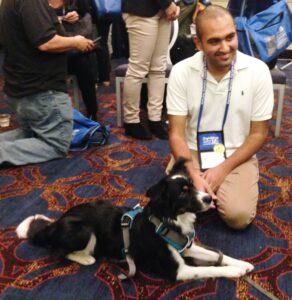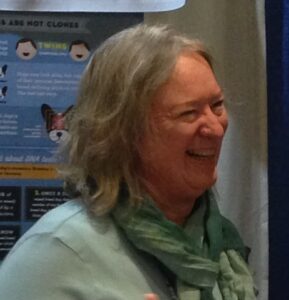Barks Blog
#PPGSummit 2015: The Future Is Now

At times, with all the cruelty and destruction in the world, it can seem disheartening for pet professionals who are trying to make a stand for animals, to be their voice and ensure they get the best care possible and are never subjected to pain and suffering along the way. While there is still great resistance from many quarters regarding the power of training via positive reinforcement – scientific study notwithstanding – as everyone in attendance at the PPG Summit already knows, the results speak for themselves.
As Ken McCort said in his presentation, The Skill of Management and Training when Dogs Are Displaying Undesired Behavior, using positive punishment when dealing with an undesirable behavior means you are reacting to what the dog has already done, which is “not a good training approach.”
“An aversive device excites a part of the nervous system that you do not want to excite,” said McCort. “A good trainer negotiates with an animal, i.e. will you do this for this?”
Bearing this in mind, we asked McCort, along with fellow presenters Pat Miller, Janis Bradley, Angelica Steinker, Lara Joseph and Chirag Patel (with PPG president Niki Tudge moderating) what they believe the future holds for the rapidly growing area of animal behavior and training. Here is what they had to say:
Q: How do you see the pet industry developing from here?

Janis Bradley: I really do think that a huge proportion of the future of dog training is in recognizing and understanding and taking advantage of the science of relationships. It wasn’t that long ago in my life with dogs that I thought that was hocus pocus, namby pamby stuff yet now we have got the solutions. It’s really real. The really great thing is that very gradually our clients actually know what we’re talking about when they talk about their relationships with their dogs. I am a crossover trainer so I have seen a big sea change in how we advise people on their relationships with their dogs and I think there is a big new [change] coming.
Ken McCort: I do think this is one of the greatest collections of experts – not just people [in the panel] but people in the audience – and dog trainers that I’ve seen for a long long time. I’m really happy to see that, for a first summit, it turned out the way it did.
The science is absolutely necessary. The more I know the more I understand what’s going on with an animal, or think I understand. We can never know it all but the science is getting better. I’m so pleased with the industry and what’s going on, especially with the science. I’m really excited about a lot of the products that are coming out that we can use to help our animals and help our clients’ animals. I think that’s a very promising future. The big thing I’d like to see in the future is the different people who work in training animals, especially in the exotic animal world, networking with others. [The latter] could use our help sometimes and we could learn a lot from them. Some are just starting out and need more education, and there are others from whose wisdom we can all benefit.
Pat Miller: This has been the best dog training conference ever. It is so cool to have been in the industry for long enough to see the change.
Chirag Patel: For me, the future of dog training is the science aspect of it. Science goes beyond learning theory and I hope that we’ll look at training as part of the care package for an animal, rather than thinking, “I just want to do training.” I think there will be lots of change in that respect.

Angelica Steinker: I see so many possibilities. I challenge everyone to be creative and to share their creativity. Let people know if you come up with a great idea. Put it in BARKS from the Guild, put it on the PPG Facebook page and share what you know. All of those great ideas can create something completely awesome.
Lara Joseph: This is the best seminar I have ever attended. I come from the exotic animal world and I am bringing awareness of PPG and the future of PPG to my clientele. There’s a big need for it in the wildlife rehabilitation community.
A field that is huge on aversives and punishment is pigs so I am pushing PPG in that area and trying to educate how positive reinforcement and applied behavior analysis do affect behavior.
Q: How do you foresee bringing the force-free movement to the horse industry? There is still so much punishment with horses and it can be a culture of cruelty.
Ken McCort: It is a process. When you’re going to change an industry and change the way people think, the first thing is that people say you are crazy and that it will never work. Then they analyze and try to find fault, and then they try it out and say they knew it would work all along. You have to stay out there and keep pushing. There is no way I’d be touching a wolf, fox or coyote using the methods I learned back in the 60s and early 70s because if I did, I’d either be dead or they wouldn’t come near me. Dogs and horses are about the only animals that you can punish who will forgive you for it so they seem to take the brunt of it and that’s a shame. Just because you can do it doesn’t make it right. By the same token I think that in some of those industries, depending on where you are, some of them are changing slowly. There’s clicker training for horses and there are more workshops on that so it’s getting there. It’s just a slow process. You guys that work with horses get out there and show what you can do and that’s how you do it. It’s all by example. We have to show people how [reward-based training] works.

Pat Miller: Most people don’t know this but before there was a Whole Dog Journal there was a Whole Horse Journal and I wrote a lot of training articles [for it], but it died from lack of support and lack of readership because the horse world wasn’t really ready for it. It may be time to revisit the idea of a Whole Horse Journal. Beezie Madden on the US equestrian team uses clicker training on her showjumpers so it’s out there. It’s coming but it’s slow.
There is huge pushback in the horse world about using treats for training because what do you do if you this 1,000 pound animal mugs you for treats. It’s so easy with a horse though. When I first started clicker training I tried it on my horse first. When I was charging the clicker I waited for her to look away from me before I clicked and now, 20 years later, I have a horse who consistently and deliberately doesn’t mug me in order to get a click and treat. How easy is that? So it’s coming but certainly the horse world is pretty resistant to it so it’s going to take some time. And, by the way, horse whispering is no more positive or force-free than dog whispering is.
Q: What do you tell a client who tells you they have been using punitive methods?
Janis Bradley: My standard pitch is the same thing that I do with anyone when I expect to get some resistance. Rather than be confrontational I’ll affirm what they said, which just means that anyone who tells you that you cannot motivate an animal with pain and fear is just silly, of course you can. Any reasonable organism will do things to avoid scary consequences but a) is that the relationship you want with your dog and b) is that why you want him to do things for you. And often I don’t have to go any further than that. They’ll mull it over just a little bit and say they want to do it more because he likes them and they want to do something pleasant. Most people don’t hire you as a behavior consultant because they hate their dogs.
Angelica Steinker: I immediately begin training them so what I do is ignore the unwanted behavior (i.e. what they just said) and ask them what they do to have fun with their dog. That way I’m not positioning myself like I’m on this side and you’re on that side, but we’re both on the side of fun.
Chirag Patel: For me, I like to inspire change through empowerment because you won’t change their behavior by saying punishment is bad. We have to try to set clients up for success and then, when they see success with their dogs, they will want to use reinforcement-based techniques rather than punishment with their dogs.

Ken McCort: Confronting the client or arguing is not why you’re there. I always keep in the back of my mind that, if they’ve called me, they already know it didn’t work. I also try to keep in mind that it’s the same relationship problem you see in human divorce – I love my spouse but hate their behavior. A lot of the times I will agree with them that yes, this is not what you want from your animal, and while I’m doing that I’m getting a good behavior from that animal right in front of me. I’m letting them see the behavior change without me saying a word to the animal and usually after a few minutes of that they’ll say, well,, what are you doing there, and that’s my guide. I tell them that we do this with a lot of other species besides dogs and that’s usually the hook for me against these guys that still want to hang on, saying [aversive training] is fast and quick. I say that it is but it’s got a lot of baggage and is not easy to do although they think it is. The problem is they don’t see the baggage.

Lara Joseph: Usually I ask them what side effects they are seeing and don’t say a word, and then I show them the alternative of how they can approach it without seeing those side effects. I give them what they think is a magic tool, a target stick, and show them the contingencies of using it. This is the first tool I use to start teaching them the power behind positive reinforcement. They all grow to love the target stick.
Janis Bradley: I have seldom had to actually have that conversation with clients and I attribute that to one technique I use, which is to narrate the events that are happening in front of me from the dog’s perspective. I do this as a conversation with the dog so I have this ongoing monolog with what I see as the dog’s perceptions. That often helps people get into a more supportive frame of mind. I also think the power of play is enormously important in supporting the relationship between the human and the dog, to figure out how to facilitate play between the owners and the dog. Play is a very powerful thing.
Pat Miller: I think it’s critically important that none of us ever says that old fashioned methods, positive punishment, or however you want to phrase it, do not work because as soon as we say that we completely destroy our credibility. They wouldn’t be perpetuated if they didn’t work. People use them because they work so it’s really important that we don’t come in and say they don’t. On the positive side, the vast majority of people that call me for training classes now ask what training methods we use and that never used to happen 20 years ago.
Q: What is the best advice you have for someone new starting out in the industry or something you had wished you had known when you started out?
Janis Bradley: If you board and train always have a screening question for separation anxiety!
Ken McCort: The big thing is to keep educating yourself. Study the things that excite you, you don’t have to be an expert on everything. Just focus on what you want to do.
Chirag Patel: I would say for young trainers or new trainers, and one of the things that I benefitted from, is to experience as many different people, trainers and classes as possible. Sometimes we get stuck with one person because we become comfortable with them, but the more classes we can see, the more trainers we can go and speak to or work with will make us more open minded about training.
Lara Joseph: Based on my experience, if I could do it all over again, I would say understand the laws of behavior and how they apply to absolutely everything.
Pat Miller: I would say get your hands on as many different dogs as you can and the best way to do that is to volunteer at a shelter.
Niki Tudge: Stay in your area of competency and don’t try and rush into doing things you really are not competent to do because that’s a really bad reflection on us and our industry. Be honest about where you are, what you are good at and stay within that. If necessary refer out to other people and/or see a veterinary behaviorist. It is not good for our industry if we are doing things we are not good at.
This article first appeared in BARKS from the Guild, January 2016, pages 15-17.
#PPGSummit 2016 is taking place at the Sheraton Tampa East hotel in Florida on November 8-11 November. Click here for more details.

